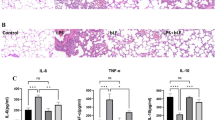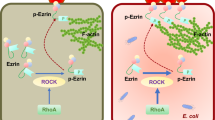Abstract
The NLR family pyrin domain-containing 3 (NLRP3) inflammasome is a cytoplasmic multimolecular complex that generates interleukin (IL)-1β and is considered a main pathogenic mechanism for uric acid-induced inflammation. Whether toll-like receptor 9 (TLR9) is responsible for uric acid-induced NLRP3 inflammasome activation remains unclear. Thus, the aim of this study was to identify the role of TLR9 in NLRP3 inflammasome activation through monosodium urate (MSU) crystal-induced mitochondrial DNA. RAW 264.7 cells treated with MSU crystals, CpG oligonucleotides (ODNs), or a combination of both were used to assess nuclear factor (NF)-κB signaling, NLRP3 inflammasome components such as NLRP3, ASC, and caspase-1, and IL-1β. Real-time polymerase chain reaction (RT-PCR), Western blotting, DNA fragmentation assay, mitochondrial DNA copy number assay, and immunofluorescence were used in the in vitro study. RAW 264.7 cells treated with CpG-ODN stimulated the activation of NF-κB signaling, the NLRP3 inflammasome components NLRP3, ASC, and caspase-1, and IL-1β gene and protein expression. DNA fragmentation assay showed that MSU crystals induced cellular apoptosis. Fragmented DNA prompted by MSU crystals induced TLR9 expression. RAW 264.7 cells treated with CpG-ODN or MSU crystals and both increased expression of mitochondrial DNA relative to nuclear DNA. CpG-ODN and MSU crystals augmented the activation of NLRP3 inflammasome components and IL-1β expression, which was significantly suppressed in RAW 264.7 cells transfected with TLR9 siRNA. This study suggests that TLR9 activated by MSU crystal-mediated mitochondrial DNA contributes to the activation of NLRP3 inflammasomes and IL-1β production.






Similar content being viewed by others
References
Choi, H.K., D.B. Mount, and A.M. Reginato. 2005. Pathogenesis of gout. Annals of Internal Medicine 143: 499–516.
Shi, Y., J.E. Evans, and K.L. Rock. 2003. Molecular identification of a danger signal that alerts the immune system to dying cells. Nature 425: 516–521.
Liu-Bryan, R., K. Pritzker, G.S. Firestein, and R. Terkeltaub. 2005. TLR2 signaling in chondrocytes derives calcium pyrophosphate dehydrate and monosodium urate crystal-induced nitric oxide generation. Journal of Immunology 174: 5016–5023.
Liu-Bryan, R., P. Scott, A. Sydlaske, D.M. Rose, and R. Terkeltaub. 2005. Innate immunity conferred by toll-like receptors 2 and 4 and myeloid differentiation factor 88 expression is pivotal to monosodium urate monohydrate crystal–induced inflammation. Arthritis and Rheumatism 52: 2936–2946.
Joosten, L.A., M.G. Netea, E. Mylona, M.I. Koenders, R.K. Malireddi, M. Oosting, R. Stienstra, F.L. van de Veerdonk, A.F. Stalenhoef, E.J. Giamarellos-Bourboulis, T.D. Kanneganti, and J.W. van der Meer. 2010. Engagement of fatty acids with toll-like receptor 2 drives interleukin-1β production via the ASC/caspase 1 pathway in monosodium urate monohydrate crystal-induced gouty arthritis. Arthritis and Rheumatism 62: 3237–3248.
Takeshita, F., C.A. Leifer, I. Gursel, K.J. Ishii, S. Takeshita, M. Gursel, and D.M. Klinman. 2001. Cutting edge: role of toll-like receptor 9 in CpG DNA-induced activation of human cells. Journal of Immunology 167: 3555–3558.
Krieg, A.M., A.K. Yi, S. Matson, T.J. Waldschmidt, G.A. Bishop, R. Teasdale, G.A. Koretzky, and D.M. Klinman. 1995. CpG motifs in bacterial DNA trigger direct B-cell activation. Nature 374: 546–549.
Klinman, D.M., A.K. Yi, S.L. Beaucage, J. Conover, and A.M. Krieg. 1996. CpG motifs present in bacteria DNA rapidly induce lymphocytes to secrete interleukin 6, interleukin 12, and interferon γ. Proceedings of the National Academy of Sciences of the United States of America 93: 2879–2883.
Lamphier, M.S., C.M. Sirois, A. Verma, D.T. Golenbock, and E. Latz. 2006. TLR9 and the recognition of self and non-self nucleic acids. Annals of the New York Academy of Sciences 1082: 31–43.
Zhang, Q., M. Raoof, Y. Chen, Y. Sumi, T. Sursal, W. Junger, K. Brohi, K. Itagaki, and C.J. Hauser. 2010. Circulating mitochondrial DAMPs cause inflammatory responses to injury. Nature 464: 104–107.
Bao, W., H. Xia, Y. Liang, Y. Ye, Y. Lu, X. Xu, A. Duan, J. He, Z. Chen, Y. Wu, X. Wang, C. Zheng, Z. Liu, and S. Shi. 2016. Toll-like receptor 9 can be activated by endogenous mitochondrial DNA to induce podocyte apoptosis. Scientific Reports 6: 22579.
Imaeda, A.B., A. Watanabe, M.A. Sohail, S. Mahmood, M. Mohamadnejad, F.S. Sutterwala, R.A. Flavell, and W.Z. Mehal. 2009. Acetaminophen-induced hepatotoxicity in mice is dependent on Tlr9 and the Nalp3 inflammasome. The Journal of Clinical Investigation 19: 305–314.
Oka, T., S. Hikoso, O. Yamaguchi, M. Taneike, T. Takeda, T. Tamai, J. Oyabu, T. Murakawa, H. Nakayama, K. Nishida, S. Akira, A. Yamamoto, I. Komuro, and K. Otsu. 2012. Mitochondrial DNA that escapes from autophagy causes inflammation and heart failure. Nature 485: 251–255.
Ding, Z., S. Liu, X. Wang, M. Khaidakov, Y. Dai, and J.L. Mehta. 2013. Oxidant stress in mitochondrial DNA damage, autophagy and inflammation in atherosclerosis. Scientific Reports 3: 1077.
Jo, E.K., J.K. Kim, D.M. Shin, and C. Sasakawa. 2016. Molecular mechanisms regulating NLRP3 inflammasome activation. Cellular & Molecular Immunology 13: 148–159.
Martinon, F. 2010. Mechanisms of uric acid crystal-mediated autoinflammation. Immunological Reviews 233: 218–232.
Li, Y., M. Liu, Z. Zuo, J. Liu, X. Yu, Y. Guan, R. Zhan, Q. Han, J. Zhang, R. Zhou, R. Sun, Z. Tian, and C. Zhang. 2017. TLR9 regulates the NF-κB-NLRP3-IL-1β pathway negatively in Salmonella-induced NKG2D-mediated intestinal inflammation. Journal of Immunology 199: 761–773.
Hoque, R., M. Sohail, A. Malik, S. Sarwar, Y. Luo, A. Shah, F. Barrat, R. Flavell, F. Gorelick, S. Husain, and W. Mehal. 2011. TLR9 and the NLRP3 inflammasome link acinar cell death with inflammation in acute pancreatitis. Gastroenterology 141: 358–369.
Choe, J.Y., K.Y. Park, and S.K. Kim. 2015. Oxidative stress by monosodium urate crystals promotes renal cell apoptosis through mitochondrial caspase-dependent pathway in human embryonic kidney 293 cells: mechanism for urate-induced nephropathy. Apoptosis 20: 38–49.
Kim, S.K., J.Y. Choe, and K.Y. Park. 2016. Enhanced p62 is responsible for mitochondrial pathway-dependent apoptosis and interleukin-1β production at the early phase by monosodium urate crystals in murine macrophage. Inflammation 39: 1603–1616.
Janeway, C.A., Jr., and R. Medzhitov. 2002. Innate immune recognition. Annual Review of Immunology 20: 197–216.
Latz, E., A. Schoenemeyer, A. Visintin, K.A. Fitzgerald, B.G. Monks, C.F. Knetter, E. Lien, N.J. Nilsen, T. Espevik, and D.T. Golenbock. 2004. TLR9 signals after translocating from the ER to CpG DNA in the lysosome. Nature Immunology 5: 190–198.
Kawai, T., and S. Akira. 2007. Signaling to NF-κB by toll-like receptors. Trends in Molecular Medicine 13: 460–469.
Chen, C.J., Y. Shi, A. Hearn, K. Fitzgerald, D. Golenbock, G. Reed, S. Akira, and K.L. Rock. 2006. MyD88-dependent IL-1 receptor signaling is essential for gouty inflammation stimulated by monosodium urate crystals. The Journal of Clinical Investigation 116: 2262–2271.
Martinon, F., V. Pétrilli, A. Mayor, A. Tardivel, and J. Tschopp. 2006. Gout-associated uric acid crystals activate the NALP3 inflammasome. Nature 440: 237–241.
Shimada, K., T.R. Crother, J. Karlin, J. Dagvadorj, N. Chiba, S. Chen, V.K. Ramanujan, A.J. Wolf, L. Vergnes, D.M. Ojcius, A. Rentsendorj, M. Vargas, C. Guerrero, Y. Wang, K.A. Fitzgerald, D.M. Underhill, T. Town, and M. Arditi. 2012. Oxidized mitochondrial DNA activates the NLRP3 inflammasome during apoptosis. Immunity 36: 401–414.
Malemud, C.J., Y, Sun, E. Pearlman, N.M. Ginley, A. Awadallah, B.A. Wisler, and J.E. Dennis. 2012 Monosodium urate and tumor necrosis factor-α increase apoptosis in human chondrocyte cultures. Rheumatology Current Research 2:113.
Tsujimura, H., T. Tamura, H.J. Kong, A. Nishiyama, K.J. Ishii, D.M. Klinman, and K. Ozato. 2004. Toll-like receptor 9 signaling activates NF-κB through IFN regulatory factor-8/IFN consensus sequence binding protein in dendritic cells. Journal of Immunology 172: 6820–6827.
Funding
This research was supported by Basic Science Research Program through the National Research Foundation of Korea funded by the Ministry of Education (NRF-2019R1F1A1061098).
Author information
Authors and Affiliations
Corresponding author
Ethics declarations
Conflict of Interest
The authors declare that they have no conflict of interest.
Additional information
Publisher’s Note
Springer Nature remains neutral with regard to jurisdictional claims in published maps and institutional affiliations.
Rights and permissions
About this article
Cite this article
Kim, SK., Park, KY. & Choe, JY. Toll-Like Receptor 9 Is Involved in NLRP3 Inflammasome Activation and IL-1β Production Through Monosodium Urate-Induced Mitochondrial DNA. Inflammation 43, 2301–2311 (2020). https://doi.org/10.1007/s10753-020-01299-6
Published:
Issue Date:
DOI: https://doi.org/10.1007/s10753-020-01299-6




